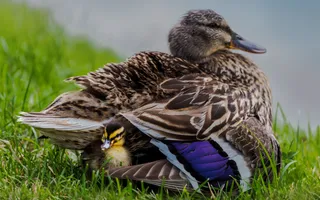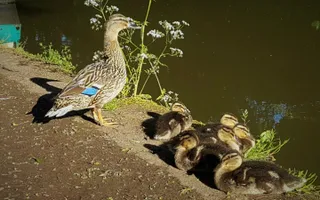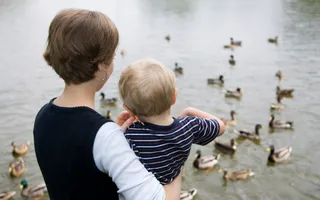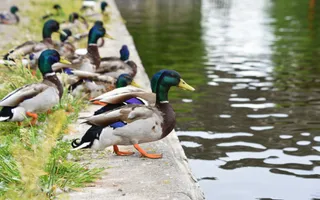Mallard facts
Family: Anas platyrhynchos
Diet: Seeds, acorns, berries, plants, insects and shellfish
Predators: Foxes, rats, mink, stoats and weasels
Size: Length 51-62cm, wingspan 81-98cm
Weight: 750-1,500g
Lifespan: Five to 10 years
About mallards
We have 22 different duck species in the UK, but the mallard is our most abundant. The male’s distinctive green head and the female’s speckled brown plumage have become a familiar and iconic sight on our network.
Mallards are dabbling ducks, meaning they feed mainly on water plants at the surface, which they get by upending in shallow water. Other dabbling duck species include the gadwall, teal and wigeon.
Mallards are social animals, living in flocks, and are well-adapted to urban areas. But if you want to feed our ducks and other water birds, please avoid giving them bread.
Are mallard ducks native to the UK?
Most of the mallards you see will be resident in the UK, but some might be visitors from northern Europe flying south for the winter.
We have about 61,000 breeding pairs and around 675,000 wintering birds.
What do mallards look like?
A large and heavy duck, the mallard has a long body with distinctive plumage. They’re about 50-65cm long with a wingspan of 81-98cm. Mallard bodies make up around two-thirds of their overall size.
Male mallards are especially known for their striking breeding plumage, with a glossy green head, white neck ring and chestnut-brown breast. Outside of the breeding season, however, both males and females adopt a more muted look known as eclipse plumage, where males resemble females with mottled brown feathers, offering better camouflage.
Hybridisation with other species and domestic ducks also results in varied plumage among mallards. In some instances, mallards may have entirely white or pale plumage.









